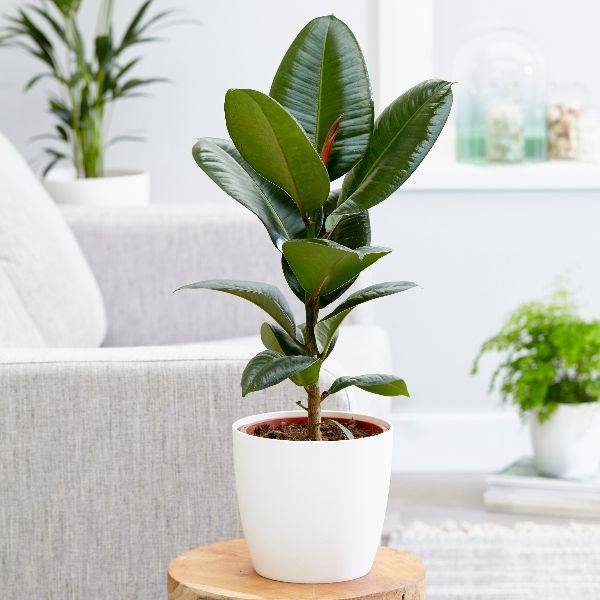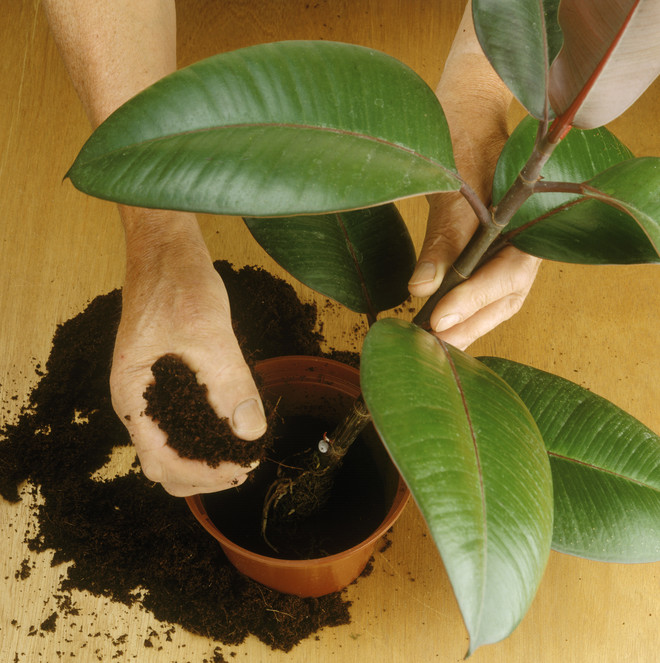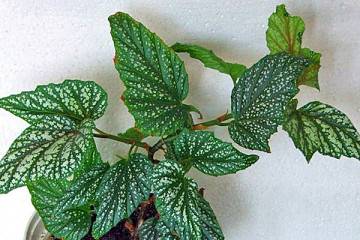Ficus Robusta rubbery - planting and care at home
Content:
Ficus elastica Robusta (lat.Ficus elastica Robusta) is one of the many varieties of this flower. Due to its beautiful appearance, unpretentious care, useful properties, the plant has become very popular for growing indoors. This type of ficus is a real decoration of any room, which always pleases flower growers with a chic green crown.
Description of Ficus Robusta
Ficus Robusta is a small bush with an erect stem. The main advantage of the plant is its large dense oval-shaped leaves with a sharp point at the ends, resembling peaks. The leaf blades are shiny, with a waxy coating of dark green color, in the middle there is a dense central vein of a reddish hue. The leaf is 20-25 cm wide and half a meter long. The trunk of the plant is also green, it is dense, with an average diameter of 5-10 cm. The height of a plant at home rarely exceeds 2 m, in natural conditions it can reach 40 m.
Ficus Robusta is a prominent representative of the tropical flora of the Mulberry family. Refers to rubber plants. Rubber ficus Robusta is considered the most unpretentious variety, he first migrated into the house and fell in love with flower growers.
This plant is appreciated not only for its noble appearance, it has a number of useful properties. Powerful sheet plates saturate the room with oxygen and effectively cleanse of harmful substances contained in the air, especially phenols and benzenes. In eastern countries, they believe in its medicinal properties, the robusta ficus helps in the fight against benign neoplasms and mastopathy. There are a number of beliefs about the energetic effect of ficus on the atmosphere in the house.
Ficus Robusta is a native of tropical latitudes. The native land of the evergreen plant is the Indonesian islands. In its natural environment, it is distributed in India, Java and Sumatra. There it is of industrial importance for the extraction of rubber (the juice of the leaves is 15% rubber), is used in construction, the manufacture of "living" bridges.
Features of caring for ficus Robusta at home
Caring for ficus Robusta at home will not cause much trouble. It is with the care of this plant that beginners are advised to start their journey. Undemanding and not capricious, it pleases with a good annual growth. It is a pleasure to look after this ficus.
The flower adapts well to living conditions. The optimum temperature is 25 ° C. A higher value can lead to the fact that the foliage begins to turn yellow, and the temperature drops below 15 ° C to the fact that the leaves begin to fall off.
Lighting requirements are minimal. Ficus gets used to both well-lit and semi-shaded conditions. The only nuance that needs to be considered is limiting direct sunlight. They cause burns to the leaf blade and the appearance of yellow spots.
The flower needs regular watering.Its frequency is chosen depending on the environmental conditions: in the summer - it is 2 times a week, in the winter - 1 time is enough.
Consideration should be given to maintaining moisture. Since a plant in tropical latitudes, it loves a high concentration of moisture in the air of 60-70%, but not less than 50%. To do this, you must regularly spray the flower from a spray bottle, and periodically wipe the leaves with a damp sponge.
It is better to choose a pot for growing ficus that is spacious, deep, and the soil is light and nutritious, with neutral acidity. A universal soil for deciduous plants or a special mixture for ficuses is perfect.
During the period of active growth (from March to November) and during transplants, the flower requires mandatory feeding. It is better to fertilize with nitrogen-rich solutions no more than 3 times a month. An excess of nutrients can lead to negative consequences and the death of the ficus.
Pruning
To form a beautiful lush crown, it is necessary to prune the ficus. After the procedure, the flower begins to actively grow in width due to lateral shoots. The best time for pruning is February-March, before the start of a period of active growth. The shoot is cut at a distance of 6 cm from the required leaf with a sharp knife or pruner.
Sanitary pruning should be carried out periodically - remove old, damaged leaves and shoots.
How ficus Robusta reproduces
There are several ways to propagate ficus. The main ones are:
- cuttings;
- layering;
- sheets.
Cutting is considered the most effective way - the cut off shoot is placed in water before the roots appear. After their appearance, the cutting is planted in soil rich in nutrients and trace elements. To create a microclimate and accelerate the rooting process, I cover the shoot with a transparent container.
Reproduction by layering is advised to be carried out on old plants. The lower shoot is cleaned of leaves, circular cuts in the bark are made at a distance of 2-3 cm. Damp cotton wool or moss is applied on top, wrapped in a film.
Reproduction by leaves is rather difficult. A leaf planted in the soil often rots, so it is preferable to use the first two methods.
Transfer
A distinctive feature of the robusta ficus is vigorous growth, which requires an annual transplant. The best time for this is spring. For this, a pot is selected, 30% larger than the previous one, at the bottom of which good drainage is made. Ficus usually tolerates transplanting well and actively releases young shoots in new soil.
Possible growing problems and diseases
Ficus Robusta is quite resistant to diseases and pests, but sometimes it can react to negative environmental conditions. For example, a plant suffers stress during the beginning of the heating season: the leaves can turn yellow, become stained, and fall off. This signals dry air, it needs to be additionally humidified. Drafts and low room temperatures can be other causes of this. The appearance of brown spots indicates waterlogging of the soil - the plant was flooded.
Pests rarely damage this type of ficus. The most likely ones are the scale insect and spider mite. To combat them, you need to spray with a solution of tincture of calendula, tobacco or the corresponding fungicides. To prevent the appearance of pests, it is necessary to periodically wipe the stem and leaves of the flower with soapy water.
Ficus Robusta does not bring any particular difficulties in care. With minimal care and attention, it will delight you with a dense green crown all year round and will fit into the interior of any room.




















